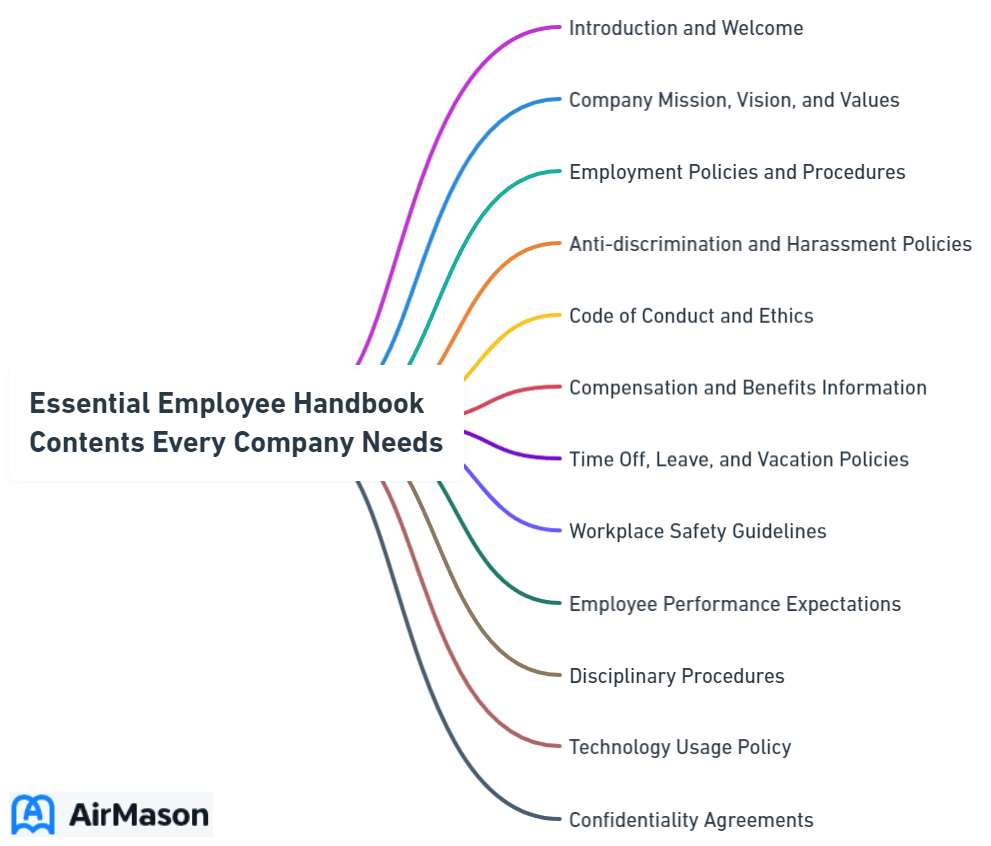
A well-crafted employee handbook is vital for every business. Discover the essential employee handbook contents, including key policies, cultural guidelines, and compliance mandates, to ensure your handbook is a valuable resource for guiding your team and protecting your company.
Key Takeaways
- An employee handbook is a critical document outlining company mission, values, expectations, legal compliance, employment policies, code of conduct, and benefits, and must be kept up-to-date for overall organizational effectiveness.
- The handbook enforces employment laws and policies, addresses workplace safety, defines employee conduct, and details anti-discrimination and harassment policies, including clear disciplinary and grievance procedures.
- Comprehensive coverage of compensation, benefits, work schedules, attendance, technology use, and data security policies ensures that employees are fully informed and equipped to contribute to a productive and harmonious work environment.
Crafting the Ultimate Employee Handbook

An employee handbook is not just a document; it’s the company’s playbook, a crucial tool that communicates the company’s mission, values, and expectations, while ensuring legal compliance and employee engagement. Employee handbooks cover core topics including:
- The company’s mission statement
- Employment policies
- Workplace code of conduct
- Compensation structure
- Benefits
- Work schedules
- Holidays
- Time off
- Job termination or resignation procedures
A systematic preparation and review process ensures the effectiveness of the handbook. Here are the steps involved:
- Start from the current company policies.
- Draft sections under each topic.
- Conduct legal vetting.
- Request written acknowledgment from employees upon receipt.
- Ensure the language is free of legal verbiage and may include digital features such as pictures, schemes, and videos for a better user experience.
- Have a legal counsel review to ensure the inclusion of necessary disclaimers, safeguarding the company from potential litigation.
Defining Your Company Culture
Embedding the company culture in the employee handbook is no mere decoration; it shapes how team members perceive and engage with the company’s ethos. The handbook should address topics that reflect the company’s values and common goals, encouraging employees to embody these values in real-world scenarios, thus promoting positive employee behavior.
Over time, the handbook can grow and adapt, incorporating elements of the company’s evolving culture and serving as a living document that reflects growth and change within the organization.

Legal Foundations and Employment Laws
The employee handbook plays a key role in communicating important company policies, procedures, and employee rights in accordance with state and federal laws. It includes the rights under acts such as the Fair Labor Standards Act and the Americans with Disabilities Act, and specific state laws related to anti-discrimination and workers’ compensation. Besides, the handbook should contain an Equal Employment Opportunity statement to affirm the company’s commitment to non-discrimination and ensure legal compliance.
At-will employment terms should be clearly communicated, indicating that employees can be terminated or may resign at any time for any legal reason. Including a disclaimer that the handbook policies may change and that the handbook does not constitute a binding employment contract is essential to maintain employer flexibility and manage employee expectations.
Health and Safety Regulations
When it comes to health and safety, the handbook is not merely a guide but an assurance of the company’s commitment to workplace safety. Employees are instructed on standardized procedures for:
- Reporting health incidents
- Emergency operations such as fire drills
- The use of Personal Protective Equipment (PPE)
- First-aid
- Smoking policies
The handbook also provides guidance on minimizing risks and details the employer’s role in providing health and safety training to mitigate risks. After all, a safe working environment, as established in the handbook, reduces employee absences and increases overall productivity.
Sample Employee Handbook PDF
Finding a comprehensive and well-structured sample employee handbook PDF is crucial for businesses of all sizes. A sample employee handbook PDF serves as a foundational document outlining company policies, procedures, and expectations for employees. By providing a clear guide for employees, it helps ensure consistency and fairness in the workplace. Moreover, a well-crafted sample employee handbook PDF can also serve as a legal safeguard for both employers and employees, outlining rights, responsibilities, and procedures for dispute resolution. When searching for a sample employee handbook PDF, it’s essential to tailor it to your specific company culture, industry regulations, and legal requirements to effectively communicate expectations and foster a positive work environment.
Essential Policies for Employee Conduct

Every company needs a compass to guide employee conduct, and this is where the employee handbook comes in. It contains:
- A code of ethics detailing expected ethical behavior
- Compliance to company policies
- Treatment of company property
- Performance expectations outlining the importance of meeting targets, completing job duties, willingness to learn, adherence to conduct policies, and fostering collaborative relationships with colleagues.
The handbook also defines potential disciplinary actions for misconduct or security breaches, including:
- Verbal warnings
- Written warnings
- Suspension
- Termination
These actions are designed to mitigate misconduct without instilling fear. Clear articulation of conduct rules and disciplinary procedures serves as a foundational tool for preventing claims of unfair treatment.
Anti-Harassment and Discrimination Policies
In the realm of workplace conduct, a zero-tolerance policy towards any form of harassment or discrimination is pivotal. The handbook clearly states this and provides specific examples of prohibited behaviors to give a clear understanding of what constitutes harassment or discrimination. The handbook includes a ‘reporting policy’ that outlines the steps employees should take to report incidents or concerns. Reporting mechanisms for harassment and discrimination are designed to be straightforward, ensuring confidentiality and providing multiple avenues for employees to report.
The handbook also details the investigation process to be followed when a complaint is made, including those related to unfair treatment claims. Anti-retaliation protections are assured, emphasizing that those who report harassment or discrimination will not face retaliation. Violating these policies may lead to disciplinary action up to and including termination of employment. If internal reporting channels prove ineffective, or if retaliation occurs, the handbook guides employees on seeking help from external agencies such as the EEOC or a legal representative.
Dress Code and Personal Appearance Standards
The way an employee presents themselves at work can reflect their respect for the job and the company. That’s why the employee handbook details acceptable personal appearance standards, including the organization’s expectations regarding work attire and the professional image it seeks to convey. Grooming and hygiene standards are also outlined. Attire requirements may vary with specific expectations such as the necessity of suits and ties for male employees in certain industries or business casual in more creative fields. Where uniforms are required for safety, branding, dress appropriateness, or productivity, the handbook states whether the company or the employees will be responsible for providing and maintaining these uniforms.
Companies might offer some flexibility in dress code through arrangements like casual Fridays, particularly for employees not in contact with clients or customers.
Compensation and Benefits Breakdown

Nothing motivates an employee more than a clear understanding of their compensation and benefits. The employee handbook should articulate salary ranges, bonus structures, and equity options such as stock options or restricted stock units, considering factors like experience, education, and performance. The handbook must clearly specify all payroll deductions, including federal, state, and local taxes as well as voluntary deductions for benefits like FSA and HSA contributions.
Comprehensive descriptions of health and welfare benefits include:
- Medical insurance
- Dental insurance
- Vision insurance
- Disability insurance
- Life insurance
- Retirement plans
- Paid time off
A system to reward performance should be in place, where managers are encouraged to recognize and recommend rewards for their team members based on merit without enforced rankings or comparisons.
Understanding Payroll and Direct Deposit
An important part of employee compensation is understanding the payroll process. Employees must enroll in direct deposit through the company’s designated procedure to receive their wages. The handbook should clarify any availability limitations for direct deposit, such as bank requirements or regional restrictions.
Employees should also be informed about the process for making changes to their direct deposit information, in case they want to switch banks or accounts.
Time Off and Leave Policies
Everyone needs a break, and the employee handbook clearly outlines various types of leave, including:
- PTO
- FMLA
- Parental leave
- Bereavement leave
- Civic duties
The handbook also details the procedures for requesting time off. It must state clearly if unused PTO can be carried over to the next year and detail the procedures for taking sick leave, including when a physician’s note is required.
For companies with over 50 employees, the handbook includes the following information:
- FMLA information, offering up to 12 weeks of unpaid, job-protected leave for qualifying medical and family reasons
- Parental leave policies, detailing the duration of paid leave, eligibility criteria, and the potential for remote work or flexible hours post-return
- Bereavement leave, including the number of paid days allowed, the option for additional unpaid leave, and permissible activities during the leave
Policies regarding civic duties must clarify:
- If leave for jury duty and voting is paid or unpaid, including documentation requirements
- If employees may receive a floating holiday
- If employees have the option for unpaid time off for religious holidays not officially recognized by the company.
Work Hours, Schedules, and Flexibility

Work hours and schedules are the lifeblood of a company’s operations. The employee handbook defines company operating hours, which are typically from 9 a.m. to 7 p.m. on weekdays, and employees are expected to be present within certain core hours, such as 9 a.m. to 11 a.m., depending on team requirements. Shift schedules are outlined for departments like customer support or shipping, which may require work outside of normal operating hours.
The handbook also discusses flexible work schedules that offer alternatives to the traditional 9–5, Monday–Friday workweek, with options such as flextime, compressed workweeks, and hybrid schedules. Eligibility for these schedules is clearly outlined, covering qualified job roles and conditions for departmental impact, job requirements, and employee performance. Accommodations in the attendance policy, including flexible work hours or remote work options, cater to individual employee needs.
The handbook ensures compliance with federal and state wage and hour laws, stating that employees covered by these regulations include:
- Non-exempt employees who are owed overtime pay for hours worked over 40 in a workweek at a rate not less than time and one-half their regular rates of pay.
- Despite flexible work policies, employees are still required to be accountable for productivity and adherence to key performance indicators.
- Tracking hours worked is crucial to ensure employees complete their tasks and maintain the negotiated flexible schedules, which must be documented.
Managers receive training to handle performance and employee management effectively, particularly in supporting flexible work arrangements. A probationary period is typically set to assess the effectiveness of a flexible work arrangement, with regular reviews to ensure alignment with business goals.
Free Employee Handbook Template Word
If you’re in search of a comprehensive and easily accessible resource for crafting an employee handbook, look no further than a free employee handbook template Word document. These templates provide a structured framework tailored to the needs of your organization, covering essential policies, procedures, and guidelines. With a free employee handbook template in Word format, you can efficiently customize the content to align with your company’s culture, values, and specific requirements. Utilizing such a template not only saves valuable time but also ensures consistency and compliance with legal regulations. Whether you’re a small startup or a large corporation, having an employee handbook is crucial for promoting transparency, communication, and clarity within your workforce. Take advantage of the convenience and flexibility offered by a free employee handbook template in Word to streamline your HR processes and empower your employees with essential information.
Employee Development and Performance Reviews
In a thriving workplace, learning never stops. The company offers training and development opportunities throughout the year, including:
- Mandated harassment and discrimination policy training to prevent workplace issues
- Effective communication training to support management
- Periodic performance reviews to assess employee’s comprehension of their job responsibilities, provide feedback, and establish future goals
- Managers holding responsibility for setting clear objectives and documenting incidents for evaluation purposes.
Setting specific, measured, attainable, relevant, and time-bound performance goals is encouraged, as is establishing collaborative goals to foster teamwork, self-managed goals to increase personal productivity, and routine progress check-ins.
Effective Use of Company Property
Company property is not just about physical assets; it’s about upholding the company values and reputation. As the company expects, employees must adhere to specific expectations regarding the use of company property, including company policy on:
- Avoiding personal usage unless authorized by a department head
- Keeping their work environment orderly
- Promptly reporting if company property, such as vehicles, is not in full operational condition.
Sensitive company information must only be shared by authorized employees. Misuse or neglect of company property is subject to disciplinary action, up to and including termination or liability for costs incurred due to damage or loss. The company reserves the right to monitor communications and company network usage to enforce policy compliance, and employees are forbidden from disabling such monitoring tools.
Communication Policies and Procedures

Communication is the key to a successful workplace. The employee handbook outlines the appropriate use of company devices and behavior on those devices, and manages the flow of communication within the organization and with external parties to inform employees.
Communications should be:
- Open and unambiguous
- Conveyed in a timely manner unless the details pertain to commercial confidentiality
- Managers should maintain credibility and trust without disclosing commercially sensitive information prematurely
Employees have the right to provide feedback without retribution and communicators should actively seek and act on this feedback to guarantee understanding.
Written or electronic messages are a key part of communication, but should ideally be supplemented by face-to-face exchanges where possible for more effective understanding and the opportunity for immediate feedback. Communication must always be:
- truthful
- ethical
- considerate, acknowledging the special needs of shift employees or those working remotely, and ensuring the information is delivered respectfully.
All news, whether positive or negative, should be shared swiftly to avoid unfounded rumors, and delaying communication until all details are finalized contradicts the company’s policy on transparency.
Technology and Data Security
In today’s digital era, technology and data security are more important than ever. Access to sensitive data is strictly limited to authorized employees and must be handled securely, following the company’s guidelines for privacy and confidentiality. Employees must receive training on secure coding practices, device security, and proper data disposal to ensure the protection of sensitive data at all stages of its lifecycle. The company mandates strong password practices, data encryption, and secure data transfer protocols to safeguard against unauthorized access or breaches.
Regular updates in the knowledge of new security threats and technology trends are emphasized to align the organization’s infrastructure, policies, and procedures with industry standards. A comprehensive Digital BYOD policy defines the acceptable use of personal devices for work, with rules about device registration, authorized software, and maintaining security standards irrespective of the work location. Employees are required to report any perceived scams, privacy breaches, or security threats, supported by detailed reporting mechanisms and compliance monitoring in the handbook.
Protocols for handling non-compliance with data security policies include specified disciplinary actions and mechanisms for regular security audits and assessments.
Best Employee Handbook PDF
When searching for the best employee handbook PDF, it’s essential to consider several factors that contribute to its effectiveness. Firstly, the content should be comprehensive, covering all necessary policies, procedures, and expectations clearly and concisely. Additionally, the handbook should be easily accessible, either through a downloadable PDF or an online platform, ensuring all employees can refer to it whenever needed. A well-designed handbook also incorporates the company’s culture and values, helping employees understand the organization’s ethos and guiding principles. Moreover, it should be regularly updated to reflect any changes in laws, regulations, or company policies, ensuring its relevance and accuracy over time. Lastly, the best employee handbook PDF fosters transparency and trust between the employer and employees, serving as a valuable resource for both parties in navigating workplace dynamics and expectations.
Navigating Employee Relationships and Workplace Rights
In a diverse workplace, accommodating individual needs and upholding employee rights is paramount. The handbook lays out how employers may need to make accommodations in their dress and appearance policies for employees with disabilities, religious beliefs, or other legally protected characteristics to ensure their rights are upheld and to promote a diverse and inclusive workplace.
The Employee Lifecycle: From Onboarding to Exit Interviews
Every employee embarks on a journey with the company, from their first day to their last. The welcome letter sets the stage, including start date, arrival information, dress code, what to bring, and agenda for the first day to smoothly integrate the new employee. Employees are shown how to access the employee manual during orientation or annual training sessions to facilitate their understanding of company policies and procedures.
Termination and severance policies outline the processes for employment termination, including notice periods, calculations for severance pay based on service length and salary, and provision of outplacement assistance.
Welcoming New Employees with a Welcome Letter
First impressions matter, and a well-crafted welcome letter significantly improves an employee’s first impression and positively impacts:
- retention
- motivation
- productivity
- feelings of inclusion
Dispatching the welcome letter immediately after a job offer is accepted can ease new hire’s anxiety, offering them reassurance and instilling confidence prior to their start date.
Welcome letters can be personalized to address the specific situations of employees, such as those working remotely or relocated, fostering a supported and inclusive atmosphere from the beginning. The welcome letter serves as an opportunity to introduce the company, imbue a sense of the company’s culture and values, and ensure the new hire is well-prepared for the onboarding process.
Emails are an effective medium for sending welcome messages due to their prompt delivery and ability to include attachments and hyperlinks; these messages are best sent by the employee’s direct manager or assisted by HR in larger organizations.
Attendance Policy and Tracking
Attendance is a crucial aspect of work ethics. The handbook sets clear expectations for punctuality and regular attendance as part of maintaining productivity and a reliable work environment. Actively involving employees in the development of the attendance policy and regularly communicating the policy to all staff promotes inclusivity and ensures its effectiveness. The handbook categorizes different types of absences and tardiness, such as excused absence, unexcused absence, and leave types, and defines the process for reporting each. A defined procedure for requesting time off and reporting tardiness is outlined, emphasizing the need for advance notice and proper approval.
Non-adherence to attendance policies may lead to disciplinary actions, deterring absenteeism and unauthorized leave. The handbook also accounts for flexibility to meet individual employee needs, potentially including arrangements like flexible work hours or remote work options.
How to Handle Complaints and Grievances
A supportive work environment is one where employees feel their concerns are heard and addressed. The employee handbook outlines a grievance procedure policy that clearly outlines the method for employees to raise complaints, fostering a supportive work environment. The handbook outlines the designated procedure on how to report grievances, which promotes trust and encourages open communication. The grievance procedure policy should be customized to comply with applicable local, state, or federal laws.
Grievances should be initially directed to an employee’s supervisor or the Human Resources department if the supervisor is the subject of the grievance. A grievance form should be filled out by the employee to officially file the complaint, detailing the specific issues encountered. The HR department is responsible for investigating grievances, which includes discussions with the employee, providing notification to the implicated party, and keeping record of all proceedings. All grievances are investigated promptly with a commitment to confidentiality, equality, and a no-retaliation policy.
The formal grievance process includes the following steps:
- The grievance decision is communicated to all relevant parties.
- Required actions are taken to ensure adherence to the decision.
- Employees have the option to appeal the grievance decision if they are unsatisfied with the outcome.
Additionally, employees are encouraged to attempt to resolve minor issues informally before escalating to the formal grievance process.
Updating and Accessing the Employee Manual
The employee handbook is a living document, and as such, it requires periodic reviews every one to two years to ensure that it remains relevant and compliant with legal regulations. When the handbook is updated, changes should be highlighted, and existing employees are required to re-read the document, sign, and date an acknowledgment form that is then kept in their employee’s personnel file. Instead of distributing only an addendum, an entirely new handbook should be provided to each employee to ensure clarity and legal protection, with each updated version clearly dated or given a version number.
Employees can access the most current version of the handbook electronically on the company intranet or shared drive, and a printed copy should also be provided in common areas like the company break room; employees are notified each time the manual is updated.
Summary
In summary, an effective employee handbook serves multiple purposes – it communicates the company’s culture, outlines its values, sets expectations, and helps employees navigate their journey within the organization. It is a vital tool that ensures legal compliance, fosters a respectful workplace, and enhances employee engagement.
Frequently Asked Questions
Which sections in the employee handbook would be most useful?
The most useful sections in the employee handbook would be equal employment opportunity, conduct, compensation and performance, benefits and leaves, health and safety, workplace guidelines, and the acknowledgment of receipt. Consider including these essential topics to create a comprehensive and informative handbook.
Which of the following is included in the employee handbook?
The employee handbook should include information about employee classification, overtime eligibility, meal and rest break policies, and information pertaining to wages and hours, as well as company behavior policies such as expectations, no smoking, dress code, attendance, use of company property, and substance abuse policies.
What would not be included in an employee handbook?
Employee handbooks typically do not include specific state-related policies such as overtime, meal and rest breaks, or sick time, especially when operating in multiple states. It’s important to remember that such policies may vary from region to region.
Why is it important to embed company culture in the employee handbook?
It is important to embed company culture in the employee handbook because it helps new employees understand and integrate into the team, and impacts how team members perceive and engage with the company’s ethos. This fosters a positive work environment and cohesive team dynamics.
What is the role of the employee handbook in upholding employment laws?
The employee handbook plays a crucial role in ensuring compliance with employment laws by communicating company policies, procedures, and employee rights.
Disclaimer:
Please be aware that the content on this page has been generated by using artificial intelligence language models and may contain errors, inconsistencies, or outdated information.
It is provided as-is without any warranties or guarantees of accuracy. We strongly recommend using this content as a starting point for further research. We disclaim any liability for damages or losses resulting from the use or reliance on this content.